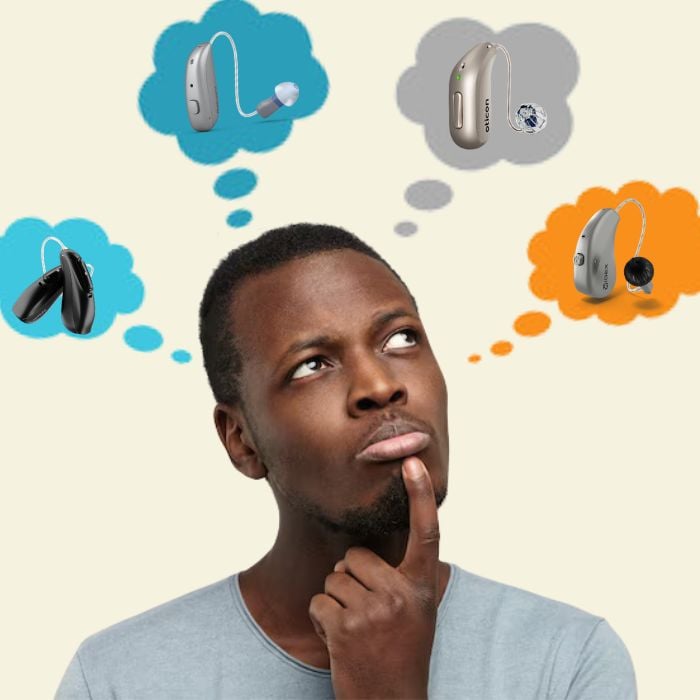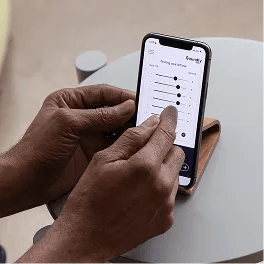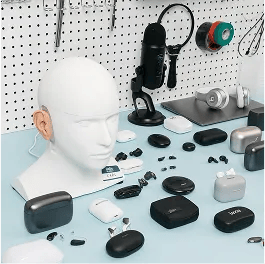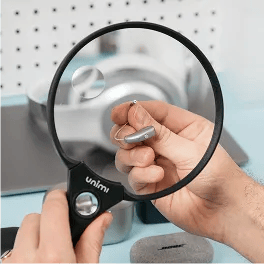Key Takeaways:
- Hearing aids are a good treatment option for conductive hearing loss
- Some patients with conductive hearing loss opt for surgery
- Work with an audiologist if you have a complex ear condition
- Focus on sound quality, good physical fit, and comfort
.png)
As an audiologist, I've supported individuals through their journeys with hearing loss. I've witnessed firsthand the challenges that come with navigating the complex world of hearing aids, particularly for those facing conductive hearing loss. It can be overwhelming to sift through the multitude of options, potential surgery, technologies, and features to find the hearing aid that not only addresses your unique hearing needs but also fits into your lifestyle seamlessly.
If you're struggling with conductive hearing loss, you've come to the right place. My goal with this guide is to simplify this process for you, drawing upon experience in the field to provide you with comprehensive, understandable, and empathetic advice on selecting the best hearing aid for you.
In this guide, we'll explore the nuances of conductive hearing loss, what to consider when choosing a hearing aid, and the best options currently available. Whether you're an adult managing hearing impairment or a parent seeking solutions for your child, this guide is designed to empower you with knowledge to make informed decisions.
Understanding Conductive Hearing Loss
Before we jump into the hearing aid options, it's essential to grasp what conductive hearing loss entails. People with conductive hearing loss might experience sound as muffled or faint, akin to hearing a conversation from another room. It can sound a bit like closing off your ear or trying to hear with earplugs in your ears. Conductive hearing loss happens when there is an 'obstacle' that prevents sound from getting to the inner ear like it normally would.
Unlike sensorineural hearing loss, which occurs when there is damage to the delicate sensory cells or to the nerves that situate in the inner ear, conductive hearing loss pertains to the inability of sound to travel effectively through the outer or middle ear. The good news is that speech clarity is typically intact with conductive hearing loss, meaning that conversations sound clear once we apply enough volume. That's where hearing aids come in.
Causes of Conductive Hearing Loss
Conductive hearing loss can be due to several factors, including ear infections, trauma or injury to the ear, fluid in the middle ear caused by colds or allergies, and issues with the bones in the middle ear. An audiologist and ENT often work together as a team to properly diagnose and treat these types of ear conditions.
It’s critical to consult with your healthcare provider for accurate diagnosis and treatment planning. They use appropriate testing methods to pinpoint the root cause of your hearing loss. Once diagnosed, the treatment options could span from medical treatments, involving medications or surgeries, to adopting hearing aids. It's always best to know your options so that you can make an informed decision about which treatment option best suits your situation and personal preferences.
Treatment Options: Surgery
Surgery is a significant consideration in the treatment of conductive hearing loss for certain individuals. It's not a universal solution, but for some, it offers a pathway to substantial hearing improvement. The suitability of surgery largely depends on the specific cause of the hearing loss and the overall health of the patient. For example, individuals with otosclerosis - a condition where abnormal bone growth in the middle ear impedes sound transmission - may greatly benefit from surgical intervention. Success rates can be high, and for some, it brings about a marked improvement in hearing ability.
To be clear, this type of surgery is specifically done to remove an obstruction that is causing the conductive hearing loss. As in the case of otosclerosis, hearing can improve postoperatively for some patients who are candidates.
Treatment Options: Bone-anchored Hearing Aids
However, it's important to note that surgery is not always the preferred or advisable path for every patient. Some individuals may not have a severe enough degree of hearing loss to warrant the risks associated with surgery. Others may opt to avoid surgical procedures due to personal preference, the potential for complications, or the advice of their healthcare team. Additionally, for a wide array of reasons, surgery might not completely resolve hearing issues, leaving patients to still consider the use of hearing aids.
Insurance coverage can also play a critical role in the decision-making process. In some instances, insurance providers are more inclined to cover the costs associated with bone-anchored hearing aids (BAHAs) or cochlear implants (CIs) compared to traditional hearing aids. This financial aspect can influence a patient's decision towards choosing surgical options, especially when these devices offer an appropriate solution to their type of hearing loss.
Each patient's situation is unique, highlighting the importance of a thorough consultation with healthcare professionals. Audiologists and ENT specialists can help guide patients through the intricate process of choosing the best treatment option, weighing the benefits and potential drawbacks of surgery against other interventions like hearing aids. Ultimately, the decision should align with the patient's specific needs, lifestyle, and personal preferences, aiming to improve their quality of life through enhanced hearing capability.
You can read more about BAHAs here.
Treatment Options: Hearing Aids
For some patients, the prospect of undergoing surgery to manage their hearing loss is daunting, or they may be deemed unsuitable candidates for surgical intervention. While certain cases of conductive hearing loss are temporary and may resolve with time or medical treatment, others face a permanent condition where medication or surgery offers no viable solution.
A prime example of this are patients with chronic ear infections, a condition characterized by fluid or drainage in the middle ear, which can significantly impede the transmission of sound. Surgery may not universally be the preferred or recommended route. For those seeking an alternative, hearing aids represent a promising solution.
Specifically designed to amplify sound and mitigate the effects of conductive hearing loss, hearing aids can dramatically improve the quality of life for patients with conditions that cause conductive hearing loss, affirming their status as excellent candidates for this non-invasive treatment option.
In addition to ear infections, several medical conditions can lead to permanent conductive hearing loss. Understanding these conditions can play a crucial role in tailoring the management and treatment approach for each individual. The following are some of the medical conditions that commonly result in permanent conductive hearing loss:
- Chronic Ear Infections: Recurring ear infections can lead to scarring and damage to the ear structures, impacting the ability of sound to travel through the ear efficiently.
- Eustachian Tube Dysfunction: Persistent dysfunction of the Eustachian tube can cause fluid buildup or negative pressure in the middle ear, hindering sound transmission.
- Cholesteatoma: An abnormal skin growth in the middle ear behind the eardrum can damage ear structures and lead to hearing loss if not treated.
- Congenital Malformations: Some individuals are born with abnormalities in the structure of their ear canals or middle ear bones, which can affect hearing ability from birth.
- Trauma or Injury: Accidents that cause physical damage to the ear or head can lead to changes in the ear's structure, affecting sound conduction.
Being aware of these conditions not only enables individuals to seek prompt medical attention but also helps in making informed decisions about their hearing health management, including the consideration of hearing aids as a viable treatment option.
Selecting the Right Care Model
Selecting the right care model plays a pivotal role in ensuring the best outcomes for individuals with conductive hearing loss. It’s vital to recognize that not all hearing loss scenarios are the same, and the care needs can vary significantly depending on the specific condition and its severity.
For individuals experiencing chronic ear drainage, those with Pressure Equalizer (PE) tubes in their ears, or those managing other ongoing ear conditions, in-person consultations with an audiologist are essential. These professionals can offer tailored advice, monitor the condition closely, and make adjustments to treatment plans as needed, ensuring that any potential complications are addressed promptly.
On the other hand, individuals who do not currently experience these scenarios (i.e., have no active drainage or infection) might find telehealth services suitable for their needs, especially if they are dealing with mild to moderate conductive hearing loss. The advent of telehealth has significantly expanded access to healthcare, allowing patients to receive expert guidance without the need for physical office visits.
The Right Hearing Aid for Conductive Hearing Loss
Selecting a hearing aid for conductive hearing loss involves considering several factors. The right hearing aid should not only address the specific nature of conductive hearing loss but should also offer comfort, discretion, and compatibility with your daily activities. The good news is that patients with conductive hearing loss have a lot to choose from when it comes to hearing aid options.
What to Look for in a Hearing Aid
A hearing aid for conductive hearing loss should primarily focus on amplifying sounds efficiently while circumventing the issues within the ear's mechanics. Here are some key features to consider:
- Sound Quality: One of the most crucial aspects to consider when selecting a hearing aid for conductive hearing loss is the sound quality it offers. You'll want a hearing aid that not only amplifies sound to make it louder but also maintains natural sound quality. For individuals with conductive hearing loss, achieving a balance in sound quality is essential. We've found that Oticon is a good option for those who prefer that softer, mellow sound.
- Comfort and Fit: Ensuring a comfortable and secure fit is crucial, especially for those with ear anomalies due to existing conditions. In this case, you'll want to work with an audiologist for the best fit and retention options.
- Bluetooth Connectivity: Bluetooth improves your audio experience, from taking phone calls to listening to your favorite podcast. Most hearing aids now come with Bluetooth connectivity options, allowing patients to connect their devices to Smartphones and other audio sources for improved convenience. Especially if you're an Android user, you'll want to check that your phone is compatible.
The Best Hearing Aids for Conductive Hearing Loss
The market is replete with hearing aids, but which are the best for those with conductive hearing loss? Here are our picks:
- Oticon Intent
- ReSound NEXIA
- Phonak Lumity
- Widex Moment Sheer
Final Thoughts
The selection of the right hearing aid or care model can appear daunting amidst the myriad of options available. However, the ultimate goal is to find a solution that enhances your quality of life, allowing you to connect more fully with the world around you. Whether it's engaging in conversations with loved ones, enjoying the sounds of nature, or experiencing your favorite music, the right hearing support can open new doors to experiences that enrich your life.
It's important to approach this journey with patience and to seek support from professionals who understand your unique needs. Together, there's a path forward to not just better hearing, but to a fuller, more vibrant life. Remember, every step taken towards improving your hearing health is a step towards reclaiming the joys and nuances of the sounds that fill our world.






